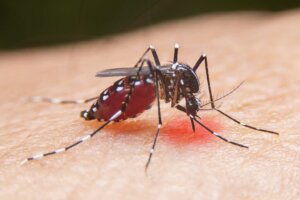The 10 Most Common Diseases in Summer


Escrito y verificado por el biólogo Samuel Antonio Sánchez Amador
Summer is one of the most anticipated times by the general population. This season is associated with discoveries, new experiences, disconnection from routine, and many positive things. In any case, it’s necessary to bear in mind that there are certain common diseases in summer that we must protect ourselves from, regardless of the location and context.
Although it’s true that viral diseases are more prevalent in winter (due to spending more time in closed spaces and the cold), there are other diseases that become much more evident when temperatures rise or the environment changes. In fact, studies estimate that up to 60% of tourists who go to low-income locations on vacation are infected with enteric infections.
Beyond gastrointestinal illnesses, other old “friends” reappear at this time of year. If you want to discover the 10 most common diseases in the summer and how to protect yourself against them, we encourage you to continue reading.
What are the most common diseases in the summer?
It’s estimated that each year, international travelers spend more than $ 230 billion visiting various parts of the world on vacation. Summer is a time of joy and discovery, but there are also exposures to potentially dangerous factors that must be considered.
For example, as indicated by the NSC Injury Facts portal, there are spikes in deaths from heat stroke and drowning in the summer months. In fact, the danger of drowning in July is higher than at any other time of the year. Winter is usually associated with a higher mortality rate, but climate change could reverse this trend little by little.
Heat strokes, diseases transmitted by biological vectors, burns, intestinal infections: There are many diseases that rebound in summer. Below, we’ll show you the 10 most common ones.
1. Heat stroke
Heat-related illness, also known as hyperthermia, is a condition that occurs when the body is exposed to alarmingly high ambient temperatures. It’s a rare process in the general population, but even so, the CDC advises us that more than 8,000 people died in the United States between 1999 and 2010 from conditions associated with heat.
This is a rare process that usually takes place 24-48 hours after the onset of a heat wave, as the body hasn’t yet had time to adapt. You’re in danger of suffering from this condition when the ambient temperature is greater than 104 ºF and the relative humidity remains above 60%.
Some of the symptoms that indicate impending heat stroke are as follows:
- Body temperature above 103 ºF ( hyperthermia).
- Red, hot, and dry skin. The patient doesn’t sweat ( anhidrosis ), something that shows the failure of the essential thermoregulatory mechanisms.
- Elevated pulse.
- Very severe headache.
- Dizziness, nausea, confusion, and loss of consciousness.
Heatstroke is much more common in older people. To avoid it, it’s necessary to consume a lot of water, limit time outdoors (or stop going out altogether) and drink a lot of fluids, especially water. During the hottest hours of the day, it’s best to stay home.
During the historic 2021 heat wave in Canada, up to 500 people may have died from complications associated with high temperatures.
2. Food poisoning and intestinal infections

According to the government portal Food Safety, 48 million food poisonings occur each year in the United States alone. This is equivalent to 1 in 6 sick inhabitants, 128,000 hospitalizations, and 3,000 deaths annually. Certainly, this group of common diseases in the summer shouldn’t be taken lightly.
There are several events that lead to food poisoning and intestinal infections. Among them, we can highlight the following:
- Viruses and Bacteria: Enteroviruses, rotaviruses, noroviruses, and hepatitis viruses are common causes of food poisoning. If we talk about bacteria, the genera Salmonella, Escherichia, and Campylobacter are the main suspects.
- Fungi: Some of those that grow on food are capable of producing mycotoxins. In this group, aflatoxins, altertoxins, and citrinin stand out.
- Parasites: Helminths and other more complex microorganisms can adhere to the walls of the intestine and cause both acute and chronic enteric diseases. Tapeworms, anisakis, or “worms” of the genus Ascaris are well-known intestinal parasites.
As we’ve said in previous lines, up to 60% of tourists who visit a low-income country during the summer end up suffering from food poisoning including diarrhea. Also, even if you don’t travel outside your home, the danger is still there: At higher temperatures, bacteria grow faster and food goes bad sooner.
To avoid food poisoning, the best tool is always to wash all food well, drink bottled water, and never buy food from seemingly unsanitary places.
3. Conjunctivitis
The term “conjunctivitis” refers to infection and inflammation of the conjunctiva, a mucous membrane that covers the back of the eyelids and the front of the eyeball. This condition is very common, especially if we take into account that it’s one of the main manifestations of allergy.
As indicated by epidemiological studies, the prevalence of allergic conjunctivitis in the general population is 15-20%, although other sources indicate much higher figures, up to 40%. Allergies are common in hot times of the year (as there’s more biological activity and pollen), so, conjunctivitis is expected to increase in summer.
Besides allergic symptoms, in the summer, we tend to bathe in common or poorly sanitized areas, such as swimming pools, the sea, or lakes. For this reason, the prevalence of viral, bacterial, and protozoal eye conditions may also increase. In summary, conjunctivitis is another of the most common diseases in summer.
The viral and bacterial infections that cause pink eye are highly contagious. If you suspect that you’ve been infected, avoid public swimming pools.
4. Flu
Influenza is an infectious disease caused by influenza virus A or influenza virus B, pathogenic microorganisms that belong to the Orthomyxoviridae family. The global incidence of this clinical picture reaches 20%, that is, up to 1 in 5 people have the flu at any given time and place. In some population groups, this figure increases to 40%.
Although it’s true that the epidemiological peaks of influenza occur in winter, due to its global presence, it’s also one of the most common diseases in summer. In addition, drastic changes in temperature (for example, from an air-conditioned room to the street) make it easier for this group of viruses to enter the body and evade the immune system.
To relieve flu symptoms, rest and drinking fluids are essential.
5. Asthma
Asthma is a chronic disease that causes inflammation and narrowing of the airways. The most common symptoms of this condition are shortness of breath, wheezing, chest tightness, and coughing. The prevalence of asthma varies greatly between regions and age groups but is usually between 3 and 7% of the world’s population.
The Asthma.org portal indicates that the symptomatic manifestations of this disease can get worse during the summer. To explain it, 2 mechanisms are proposed:
- Breathing hot air could cause a decrease in the diameter of the airways. This will make the cough and feeling short of breath worse.
- When it’s hot, more pollen tends to collect in the environment. Remember that in spring and summer, biological activity reaches its annual peak.
For this reason, it’s especially important to always carry inhalers and relevant medications on vacation if you’re an asthmatic patient. If the condition worsens a lot during the summer and you have to resort to pharmacology more than normal, it’s time to go for a medical check-up.
6. Insect bites and related diseases
A vector is any biological agent that transmits a disease to a living being. Many vectors are famous for making humans sick with their bites, but without a doubt, mosquitoes and ticks are the first that come to mind in all cases.
Parasites infect the vectors, but they don’t diminish their biological efficacy. Therefore, a mosquito can land on a person and, by feeding on their blood, inoculate a bacterium or pathogenic microorganism that in turn, causes a clinical picture. These are some of the most famous diseases transmitted by invertebrate vectors:
- Malaria: The parasite that causes this disease is carried by mosquitoes of the genus Anopheles. In 2019 alone, more than 229 million new cases were registered, of which 400,000 ended with the death of the patient.
- Dengue: The virus that causes this clinical picture is carried by female mosquitoes of the genus Aedes. In 2013, some 60 million new cases were detected worldwide, but luckily, today there’s a vaccine to combat dengue.
- Lyme disease: This disease is transmitted by the bite of a tick, an arthropod that feeds on the blood of various vertebrates. The causal bacteria is Borrelia burgdorferi.
Due to the exponential increase in vectors with heat, it can be assumed that many of these diseases become more common in summer. In addition, traveling to “exotic” areas increases the chances of getting sick from bites, especially if the appropriate prophylactic measures haven’t been taken before leaving for the destination.
If you go to the forest, take mosquito repellants with you and wear long-sleeved clothes. In tropical regions where diseases are endemic, preventive drugs, mosquito nets, and other measures are essential.
7. Mumps
Mumps is a contagious disease that’s located primarily in the parotid glands, located behind the jaw. It’s caused by the microorganism Mumps ortho rubulavirus, and before universal vaccination, 90% of young adults had had the disease.
The infection produces lifelong immunity to the pathogen and can be prevented with the MMR vaccine. Unvaccinated children are at risk of developing mumps in summer, especially because of the close contact between infants that takes place during camps and stays away from home. As studies indicate, epidemiological peaks are between 68 and 77 ºF in temperature.
8. Sunburn
Although they’re not common diseases (but rather injuries), sunburns deserve an honorable mention among the 10 most common summer diseases, as 1 in 3 inhabitants in high-income regions admit to having burned in the last year. These figures aren’t at all positive, as we remember that exposure to UV light is a risk factor in the development of skin cancer.
As indicated by the WebMD portal, 60,000 people die each year from overexposure to the sun, either from malignant melanomas or other types of skin cancer. Sunbathing for a while in summer isn’t necessarily bad, but we always recommend going to the beach with maximum protection sunscreen.
9. Otitis

Otitis is an inflammation of the ear or its surrounding tissues, usually caused by a viral, fungal, or bacterial infection. Depending on the anatomical location of the lesions, otitis can be external or medial and of acute or chronic presentation. It’s one of the most common diseases in summer because at this time of year, we usually put our ears in contact with water.
In these months, swimmer’s ear is especially common, a type of bacterial otitis that occurs when contaminated water enters the ears, usually after swimming in pools. The most common symptoms are pain, purulent ear discharge, itching, and redness of the affected area. Fortunately, it’s easily treated with antibiotics in the form of drops.
10. Cystitis
The term “cystitis” describes inflammation of the bladder. As indicated by the Urology Healthportal, urinary tract infections are common in summer, as increased temperatures and dehydration (with subsequent urine concentration) encourage microorganisms to proliferate in various structures related to urination.
To avoid these types of conditions in the summer, the following tips can be followed:
- Urinate after sexual activity: Although it sounds strange, in the case of women, this can prevent the settlement of bacteria that may have infiltrated through the action of intercourse.
- Drink plenty of water and soft drinks to stay hydrated.
- Urinate when necessary: Holding urine in the bladder for longer than directed can encourage the growth of pathogenic microorganisms. If you’re traveling, don’t forget to urinate before getting into the car or plane.
- Sanitize the anal and genital area well: With heat, microorganisms proliferate faster or in places where they normally wouldn’t. Staying clean in the summer is essential.
Preventing common summer illnesses is easy
Although here we’ve presented you with 10 diseases that increase their incidence in summer, without a doubt, the most common are food poisoning, heat stroke, and vector-borne diseases. All of them are easy to avoid: Cleaning your food well, drinking lots of water, staying safe from the sun, and using repellants should suffice.
If you’re going on a trip to an inhospitable or little-known region, you should practice extreme precaution. Go to the doctor, get vaccinated if necessary, and find out about the pharmacological therapies that you should follow before embarking on your adventure. Your summer experience will depend on your planning ability, so don’t leave anything to chance.
Summer is one of the most anticipated times by the general population. This season is associated with discoveries, new experiences, disconnection from routine, and many positive things. In any case, it’s necessary to bear in mind that there are certain common diseases in summer that we must protect ourselves from, regardless of the location and context.
Although it’s true that viral diseases are more prevalent in winter (due to spending more time in closed spaces and the cold), there are other diseases that become much more evident when temperatures rise or the environment changes. In fact, studies estimate that up to 60% of tourists who go to low-income locations on vacation are infected with enteric infections.
Beyond gastrointestinal illnesses, other old “friends” reappear at this time of year. If you want to discover the 10 most common diseases in the summer and how to protect yourself against them, we encourage you to continue reading.
What are the most common diseases in the summer?
It’s estimated that each year, international travelers spend more than $ 230 billion visiting various parts of the world on vacation. Summer is a time of joy and discovery, but there are also exposures to potentially dangerous factors that must be considered.
For example, as indicated by the NSC Injury Facts portal, there are spikes in deaths from heat stroke and drowning in the summer months. In fact, the danger of drowning in July is higher than at any other time of the year. Winter is usually associated with a higher mortality rate, but climate change could reverse this trend little by little.
Heat strokes, diseases transmitted by biological vectors, burns, intestinal infections: There are many diseases that rebound in summer. Below, we’ll show you the 10 most common ones.
1. Heat stroke
Heat-related illness, also known as hyperthermia, is a condition that occurs when the body is exposed to alarmingly high ambient temperatures. It’s a rare process in the general population, but even so, the CDC advises us that more than 8,000 people died in the United States between 1999 and 2010 from conditions associated with heat.
This is a rare process that usually takes place 24-48 hours after the onset of a heat wave, as the body hasn’t yet had time to adapt. You’re in danger of suffering from this condition when the ambient temperature is greater than 104 ºF and the relative humidity remains above 60%.
Some of the symptoms that indicate impending heat stroke are as follows:
- Body temperature above 103 ºF ( hyperthermia).
- Red, hot, and dry skin. The patient doesn’t sweat ( anhidrosis ), something that shows the failure of the essential thermoregulatory mechanisms.
- Elevated pulse.
- Very severe headache.
- Dizziness, nausea, confusion, and loss of consciousness.
Heatstroke is much more common in older people. To avoid it, it’s necessary to consume a lot of water, limit time outdoors (or stop going out altogether) and drink a lot of fluids, especially water. During the hottest hours of the day, it’s best to stay home.
During the historic 2021 heat wave in Canada, up to 500 people may have died from complications associated with high temperatures.
2. Food poisoning and intestinal infections

According to the government portal Food Safety, 48 million food poisonings occur each year in the United States alone. This is equivalent to 1 in 6 sick inhabitants, 128,000 hospitalizations, and 3,000 deaths annually. Certainly, this group of common diseases in the summer shouldn’t be taken lightly.
There are several events that lead to food poisoning and intestinal infections. Among them, we can highlight the following:
- Viruses and Bacteria: Enteroviruses, rotaviruses, noroviruses, and hepatitis viruses are common causes of food poisoning. If we talk about bacteria, the genera Salmonella, Escherichia, and Campylobacter are the main suspects.
- Fungi: Some of those that grow on food are capable of producing mycotoxins. In this group, aflatoxins, altertoxins, and citrinin stand out.
- Parasites: Helminths and other more complex microorganisms can adhere to the walls of the intestine and cause both acute and chronic enteric diseases. Tapeworms, anisakis, or “worms” of the genus Ascaris are well-known intestinal parasites.
As we’ve said in previous lines, up to 60% of tourists who visit a low-income country during the summer end up suffering from food poisoning including diarrhea. Also, even if you don’t travel outside your home, the danger is still there: At higher temperatures, bacteria grow faster and food goes bad sooner.
To avoid food poisoning, the best tool is always to wash all food well, drink bottled water, and never buy food from seemingly unsanitary places.
3. Conjunctivitis
The term “conjunctivitis” refers to infection and inflammation of the conjunctiva, a mucous membrane that covers the back of the eyelids and the front of the eyeball. This condition is very common, especially if we take into account that it’s one of the main manifestations of allergy.
As indicated by epidemiological studies, the prevalence of allergic conjunctivitis in the general population is 15-20%, although other sources indicate much higher figures, up to 40%. Allergies are common in hot times of the year (as there’s more biological activity and pollen), so, conjunctivitis is expected to increase in summer.
Besides allergic symptoms, in the summer, we tend to bathe in common or poorly sanitized areas, such as swimming pools, the sea, or lakes. For this reason, the prevalence of viral, bacterial, and protozoal eye conditions may also increase. In summary, conjunctivitis is another of the most common diseases in summer.
The viral and bacterial infections that cause pink eye are highly contagious. If you suspect that you’ve been infected, avoid public swimming pools.
4. Flu
Influenza is an infectious disease caused by influenza virus A or influenza virus B, pathogenic microorganisms that belong to the Orthomyxoviridae family. The global incidence of this clinical picture reaches 20%, that is, up to 1 in 5 people have the flu at any given time and place. In some population groups, this figure increases to 40%.
Although it’s true that the epidemiological peaks of influenza occur in winter, due to its global presence, it’s also one of the most common diseases in summer. In addition, drastic changes in temperature (for example, from an air-conditioned room to the street) make it easier for this group of viruses to enter the body and evade the immune system.
To relieve flu symptoms, rest and drinking fluids are essential.
5. Asthma
Asthma is a chronic disease that causes inflammation and narrowing of the airways. The most common symptoms of this condition are shortness of breath, wheezing, chest tightness, and coughing. The prevalence of asthma varies greatly between regions and age groups but is usually between 3 and 7% of the world’s population.
The Asthma.org portal indicates that the symptomatic manifestations of this disease can get worse during the summer. To explain it, 2 mechanisms are proposed:
- Breathing hot air could cause a decrease in the diameter of the airways. This will make the cough and feeling short of breath worse.
- When it’s hot, more pollen tends to collect in the environment. Remember that in spring and summer, biological activity reaches its annual peak.
For this reason, it’s especially important to always carry inhalers and relevant medications on vacation if you’re an asthmatic patient. If the condition worsens a lot during the summer and you have to resort to pharmacology more than normal, it’s time to go for a medical check-up.
6. Insect bites and related diseases
A vector is any biological agent that transmits a disease to a living being. Many vectors are famous for making humans sick with their bites, but without a doubt, mosquitoes and ticks are the first that come to mind in all cases.
Parasites infect the vectors, but they don’t diminish their biological efficacy. Therefore, a mosquito can land on a person and, by feeding on their blood, inoculate a bacterium or pathogenic microorganism that in turn, causes a clinical picture. These are some of the most famous diseases transmitted by invertebrate vectors:
- Malaria: The parasite that causes this disease is carried by mosquitoes of the genus Anopheles. In 2019 alone, more than 229 million new cases were registered, of which 400,000 ended with the death of the patient.
- Dengue: The virus that causes this clinical picture is carried by female mosquitoes of the genus Aedes. In 2013, some 60 million new cases were detected worldwide, but luckily, today there’s a vaccine to combat dengue.
- Lyme disease: This disease is transmitted by the bite of a tick, an arthropod that feeds on the blood of various vertebrates. The causal bacteria is Borrelia burgdorferi.
Due to the exponential increase in vectors with heat, it can be assumed that many of these diseases become more common in summer. In addition, traveling to “exotic” areas increases the chances of getting sick from bites, especially if the appropriate prophylactic measures haven’t been taken before leaving for the destination.
If you go to the forest, take mosquito repellants with you and wear long-sleeved clothes. In tropical regions where diseases are endemic, preventive drugs, mosquito nets, and other measures are essential.
7. Mumps
Mumps is a contagious disease that’s located primarily in the parotid glands, located behind the jaw. It’s caused by the microorganism Mumps ortho rubulavirus, and before universal vaccination, 90% of young adults had had the disease.
The infection produces lifelong immunity to the pathogen and can be prevented with the MMR vaccine. Unvaccinated children are at risk of developing mumps in summer, especially because of the close contact between infants that takes place during camps and stays away from home. As studies indicate, epidemiological peaks are between 68 and 77 ºF in temperature.
8. Sunburn
Although they’re not common diseases (but rather injuries), sunburns deserve an honorable mention among the 10 most common summer diseases, as 1 in 3 inhabitants in high-income regions admit to having burned in the last year. These figures aren’t at all positive, as we remember that exposure to UV light is a risk factor in the development of skin cancer.
As indicated by the WebMD portal, 60,000 people die each year from overexposure to the sun, either from malignant melanomas or other types of skin cancer. Sunbathing for a while in summer isn’t necessarily bad, but we always recommend going to the beach with maximum protection sunscreen.
9. Otitis

Otitis is an inflammation of the ear or its surrounding tissues, usually caused by a viral, fungal, or bacterial infection. Depending on the anatomical location of the lesions, otitis can be external or medial and of acute or chronic presentation. It’s one of the most common diseases in summer because at this time of year, we usually put our ears in contact with water.
In these months, swimmer’s ear is especially common, a type of bacterial otitis that occurs when contaminated water enters the ears, usually after swimming in pools. The most common symptoms are pain, purulent ear discharge, itching, and redness of the affected area. Fortunately, it’s easily treated with antibiotics in the form of drops.
10. Cystitis
The term “cystitis” describes inflammation of the bladder. As indicated by the Urology Healthportal, urinary tract infections are common in summer, as increased temperatures and dehydration (with subsequent urine concentration) encourage microorganisms to proliferate in various structures related to urination.
To avoid these types of conditions in the summer, the following tips can be followed:
- Urinate after sexual activity: Although it sounds strange, in the case of women, this can prevent the settlement of bacteria that may have infiltrated through the action of intercourse.
- Drink plenty of water and soft drinks to stay hydrated.
- Urinate when necessary: Holding urine in the bladder for longer than directed can encourage the growth of pathogenic microorganisms. If you’re traveling, don’t forget to urinate before getting into the car or plane.
- Sanitize the anal and genital area well: With heat, microorganisms proliferate faster or in places where they normally wouldn’t. Staying clean in the summer is essential.
Preventing common summer illnesses is easy
Although here we’ve presented you with 10 diseases that increase their incidence in summer, without a doubt, the most common are food poisoning, heat stroke, and vector-borne diseases. All of them are easy to avoid: Cleaning your food well, drinking lots of water, staying safe from the sun, and using repellants should suffice.
If you’re going on a trip to an inhospitable or little-known region, you should practice extreme precaution. Go to the doctor, get vaccinated if necessary, and find out about the pharmacological therapies that you should follow before embarking on your adventure. Your summer experience will depend on your planning ability, so don’t leave anything to chance.
- Steffen, R. (2005). Epidemiology of traveler’s diarrhea. Clinical Infectious Diseases, 41(Supplement_8), S536-S540.
- Deaths by Month, NSC Injury facts. Recogido a 31 de julio en https://injuryfacts.nsc.org/all-injuries/preventable-death-overview/deaths-by-month/
- Picture of America: Heat related illness. Recogido a 31 de julio en https://www.cdc.gov/pictureofamerica/pdfs/picture_of_america_heat-related_illness.pdf
- Food poisoning, food safety. Recogido a 31 de julio en https://www.foodsafety.gov/food-poisoning#:~:text=While%20the%20American%20food%20supply,128%2C000%20hospitalizations%20and%203%2C000%20deaths.
- Rosario, N., & Bielory, L. (2011). Epidemiology of allergic conjunctivitis. Current opinion in allergy and clinical immunology, 11(5), 471-476.
- Weather, Asthma.uk. Recogido a 31 de julio en https://www.asthma.org.uk/advice/triggers/weather/
- The association between the incidence of mumps and meteorological parameters in Taiwan
- Avoid a UTI as the summer heats up, Urology Health. Recogido a 31 de julio en https://www.urologyhealth.org/healthy-living/care-blog/2017/avoid-a-uti-as-the-summer-heats-up
Este texto se ofrece únicamente con propósitos informativos y no reemplaza la consulta con un profesional. Ante dudas, consulta a tu especialista.







